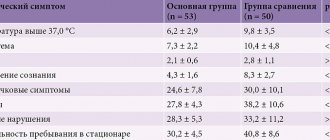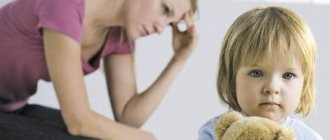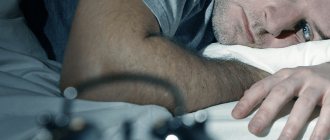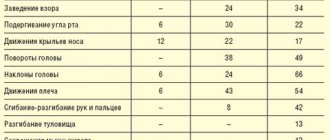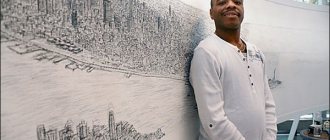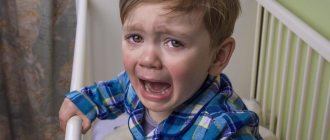Kanner syndrome
2. Kanner syndrome
Described in 1943. The prevalence of autism, according to various sources, ranges from 2 to 20 cases per 10,000 children (the following data are also given: 1 per 100–1000 newborns). The disorder occurs 3–5 times more often in boys than in girls. There is a tendency towards its increase. Etiology (Greek aitia - cause; logos - science) has not been established. Some authors suggest a connection between the disorder and schizophrenia, others see its cause in damage to the female sex chromosome, autosomal recessive pathology, and intrauterine infections.
The concept of “autism” is characterized by a significant degree of uncertainty. Thus, according to DSM-4, autism is understood as severe and specific limitations in the ability to mutual social interaction, communication and fantasy, and special, primarily stereotypical behavior. L. Gillberg and K. Gillberg (2014) indicate that most diagnostic models of autism fit into the Wing triad:
1) a significant decrease in the ability for normal mutual social interaction, which manifests itself early in the inability to communicate, a relative loss of interest in the environment, one-sidedness in contact, a reduced ability to regulate social interaction with the help of gaze, facial expressions, gestures and body language, preference for loneliness;
2) a significant lack of communication with late delayed speech development (various babbling), which is not replaced by facial expressions; lack of understanding of gestures, wordplay; inability to attract attention to oneself; repetition of the last sentence heard or part of it - echolalia. If there is an understanding of speech, then it is concrete and at first without understanding its social communicative meaning. The ability to understand symbols is significantly reduced. Half of all children with autism never use speech;
3) a pronounced restriction of behavior patterns - with rituals, resistance to everything new, focus on certain things, details, people. A narrow area of interest, often motor stereotypies (primarily stereotypical movements of the hands and fingers) and repetitive, perhaps even self-destructive body movements. Most often, strange reactions to light, sound, pain, smell, heat, and cold also occur. Hyperactivity gives way to passivity or loss of initiative. Sometimes there is a desire to eat inedible things (soil, flowers, paper).
Currently, the prevailing point of view is that autism is a unique state of mental and social deficiency. The understanding that autism can also be productive, with symptoms that are the opposite of “empty autism,” seems to be lost or almost lost.
Early signs of Kanner syndrome are found in 2/3 of infants in the first 3–4 months after birth. There is no eye contact, social smile, animation complex, communicative babble, orienting reflex; new impressions cause a reaction of dissatisfaction or fear in the child. Babies do not ask to be held, do not chase after their mother, do not latch on well, and refuse the breast early. When picked up, they do not take a comfortable position. Signs of neuropathy are often detected.
It is noted that in a third of patients, development in the first 2–3 years of life after birth may be normal; symptoms of autism appear towards the end of early childhood.
The most pronounced signs of Kanner syndrome appear in patients aged from 2 to 4–5 years. A lack of interest in the environment, self-absorption, an inability to form attachments, and a tendency to solitude are revealed. The development of emotions is delayed, indifference, fears, dissatisfaction, aggressive and auto-aggressive tendencies predominate in patients. There is an impoverishment of facial expressions, gestures, and empathy; patients do not understand the meaning of expressive acts. There is a delay in the development of speech, social thinking, self-awareness, difficulties in mastering pronouns, strange, monotonous and devoid of social content games are observed, children play mostly alone, games are manipulative in nature.
Stereotyped body movements reminiscent of hyperkinesis are characteristic. The phenomenon of identity is typical: the need for the immutability of the environment. At times, children become excited, scream loudly, periods of excitement are replaced by states of lethargy, aspontaneity, and drowsiness. Patients up to 3–4 years of age and later do not distinguish between animate and inanimate objects. Various symptoms of organic brain deficiency are identified, and 25–40% of patients experience epileptic seizures.
After 4–5 years, the symptoms of the disorder gradually smooth out. Children speak better, become more sociable, to one degree or another acquire self-care and personal hygiene skills, and learn to express their needs and desires. However, the main symptoms of the disorder, such as autism, emotional blockage, inability to form attachments, develop strong prosocial interests and hobbies, are not overcome, disturbances in interpersonal contacts and difficulties in socialization persist indefinitely.
There is no specific treatment. Approximately 2/3 of patients remain severely handicapped, unable to adapt, and dependent either on their relatives or on those caring for them in specialized institutions. Most patients aged 6–7 years are diagnosed with mental retardation, in some cases – schizophrenia.
Illustrations (Comer, 2002; Carson et al., 2004):
1. R., the first child in the family. Childbirth is difficult, with asphyxia (Greek asphyxia - suffocation). Subsequent physical development, motor skills, and self-care skills corresponded to age (according to parents). The parents were concerned that R's communication was impaired and that he was not playing normal games. For some time, the parents thought that R. was deaf, since he did not pay attention to what was said to him. R. prefers loneliness and tries to stay away from other people. He does not greet his mother or father in the morning and when they return home, he is indifferent to his younger brother. His babble lacked the intonation of a conversation with others. At the age of 3, he learned to understand simple practical requests, but still cannot express his needs. For example, instead of communicating his thirst, he asks: “Are you thirsty?” His speech contains many repetitions of words and phrases that he has heard before, while maintaining the original intonation. He cannot communicate through gestures and facial expressions. R. loves bright colors and rotating objects, looks at them for a long time, while laughing, clapping his hands, dancing or walking on tiptoes. He does the same thing when he listens to music. He likes to play with the little car he keeps with him, place kitchen utensils on the floor, and periodically run in circles. All attempts by adults to change or expand his interests meet with his resistance. For example, if his car is taken away, he gets angry, screams, fights, and tries to bite himself or others. Testing showed that R. is developmentally delayed in areas related to speech skills.
2. Turning to the past, S., Mark’s mother, recalls some things that even then seemed strange to her. For example, she recalls that when she approached Mark, he never seemed to have a presentiment that he would be picked up. Additionally, despite his attachment to the pacifier, he showed little interest in toys. Whenever the pacifier was misplaced, he expressed dissatisfaction. Mark rarely pointed at anything and seemed oblivious to sounds. The boy spent most of his time rhythmically tapping the slats of the crib, and seemed to be deeply immersed in his own world. When Mark was 2 years old, his parents began to seriously worry about his behavior. Mark, they say, usually always “looked through” or past a person, but very rarely directly at a person. He could speak a few words, but he didn't seem to understand human speech. In fact, he didn't even react to his own name. The boy spent all his time exploring familiar objects, which he twisted and turned in his hands, holding them right before his eyes. The parents were especially concerned about Mark's strange movements (he could suddenly jump, start waving his arms, squeezing or twisting his fingers, and made the strangest grimaces, especially when he was excited), as well as what the boy's father described as Mark's rigidity. Mark loved to arrange objects in neat rows and would scream loudly when this order was disturbed. He insisted that everything stay in the same place, and was very upset every time his mother tried to rearrange the furniture in the living room. After 5 years, Mark's condition began to slowly improve.
Does your child have Kanner syndrome? We know how to help! Call us
Return to Contents
"Kanner's disease as one of the varieties of early childhood autism"
Author: Sergeeva Anna Sergeevna
Kanner's disease is one of the types of early childhood autism.
Kanner's disease, described by an American child psychiatrist in 1943, is a non-professional variant of early childhood autism (EDA).
Epidemiology. This is a relatively rare disease, the prevalence of which ranges from 0.06 to 0.17 per 1000 children. In boys, the disease occurs more often than in girls; the ratio, according to various authors, is from 1.4:1 to 4.8:1.
Etiology. The main factors in the etiology of Kanner's disease are currently considered to be early exogenous-organic brain lesions, as well as genetic (schizoid spectrum) factors or their complex combinations.
Pathogenesis. Kanner's disease is mainly associated with neuropsychological mechanisms within the framework of the telencephalic hypothesis of specific disorders of the relationship between speech, sensory perception and behavioral motivation.
Dichotic listening in children with Kanner's disease did not reveal normal dominance of the right ear. In addition, nonverbal (musical) stimuli turned out to be predominant in them in comparison with verbal auditory stimuli, which may be explained by the lack of interest in speech in these children.
On the EEG, the average voltage of the left hemisphere did not show a normal excess over the right. When measuring the width of the parieto-occipital region during computed tomography in 16 patients, in 9 cases the right parieto-occipital region predominated over the left. This type of ratio occurs only in 23 and 25 percent, respectively, among large groups of mental retardation and neurological patients.
LGTsai, when studying lateralization along the dominant arm in 34 patients with Kanner's disease, revealed that in 20 of them lateralization was formed, and in the rest it was absent.
It is known that mental retardation is observed in at least 3/4 of cases of Kanner's disease. Among the numerous syndromes accompanied by mental retardation and linked to the X chromosome, N. Lubs, discovered in 1969, is of particular importance when considering the problem. the phenomenon of fragility or fragility of the X chromosome, found in some patients in whom mental retardation, judging by genealogical data, is inherited in a sex-linked manner. It turned out that the cytogenetic phenomenon of X chromosome fragility is more often found in mentally retarded patients with specific phenotypic characteristics in the form of peculiar craniofacial dysplasia, designated as Martin-Bel1-syndrome. Due to the fact that mentally retarded children with this syndrome are characterized by psychopathological features in the form of autistic isolation, difficulties in communicative functions and interpersonal interactions and other psychopathological symptoms characteristic of early childhood autism, increased attention is currently being paid throughout the world to studying the frequency of the fragility phenomenon X chromosomes in early childhood autism.
Clinical picture. The main signs of the disease are caused by weakness of instincts, a pronounced lack or complete lack of desire for contacts with others, isolation from the outside world, weak emotional reactions to loved ones, up to complete indifference to them ["affective blockade" according to Kanner, 1943], insufficient ability to differentiate people, animals and inanimate objects (protodiacrisis), insufficient reaction to visual and auditory stimuli, giving children an external resemblance to the blind and deaf, fear of everything new (neophobia), monotonous behavior with a tendency to stereotypical regressive movements (athetoid-like movements of the fingers, shaking and rotation of the hands, jumping, walking and running on the tips of the fingers). Intellectual development is impaired in most cases. According to L. Wing (1975), 55% of children have profound mental retardation, and 15-20% have mild intellectual disability. At the same time, in about 1/3 of cases, intellectual development is within normal limits.
The most pronounced manifestations of the disease are observed in children of early and preschool age. Subsequently, transformation occurs into other forms of pathology. According to many authors [Mnukhin S.S., “1968; Kagan V. E., 19K1; Kapper L., 1956;], the main part of Kanner's disease transforms with age into atypical mental retardation. In patients with normal intellectual development based on Kanner's disease, the development of schizoid psychopathy is possible [Bashina V. M., 1977; Kagan V.E., 1981].
The first manifestations of early childhood autism are detected in infancy in the form of the absence of the “revitalization complex” characteristic of healthy infants when in contact with the mother and other loved ones. Children do not react to the presence or removal of the mother, do not REACH for her, and when picked up remain passive or rigid. A negativistic form of reaction is also possible when contacting the mother, when the child treats her unkindly, drives her away from him and not only does not hug or cling to her, but even tries to hit her. There is also a symbiotic form of contact observed in older children, when the child refuses to be left without his mother, is anxious in her absence and at the same time never shows affection to her [Bashina V. M., 1974].
Clinical and psychopathological structure of RDA. V.V. Lebedinsky (1985), who classifies RDA as a distorted mental development, identifies the symptoms of autism as the main, core formation, which largely determines the clinical and psychological structure of this developmental anomaly. Autism manifests itself in “withdrawal”, a significant decrease in contacts with others or their complete absence, and immersion in one’s inner world. The child avoids revealing the content of his inner world, often does not maintain a conversation at all, and remains silent in response to questions asked. And only by unexpected phrases, randomly spoken words, sounds, gestures can one indirectly guess about his fears, experiences, fantasies.
Avoidance of contact in autism is manifested in the fact that the child, even in the presence of relatives or being in a group of peers, seems to ignore those around him, remains distant and isolated. He does not answer questions, looks “past” the children. Even if he plays “near” the children, he essentially remains alone, silent or talking to himself. Children are characterized by a lack of empathy towards loved ones, traits of coldness and aloofness.
Along with the lack of an adequate emotional response to the situation, weakness of emotional resonance, patients are characterized by hyperesthesia to light, auditory, tactile, and temperature stimuli. This leads to the fact that the environment for a child with RDA becomes a source of emotional discomfort; its perception is accompanied by a constant negative mood background. Children are highly vulnerable to harsh tone and remarks addressed to them. The human face also often becomes an excessive stimulus, which explains the lack of direct eye contact.
Painful hyperesthesia and the accompanying emotional discomfort create, according to V.V. Lebedinsky (1985), the basis for the emergence of fears.
According to special experimental psychological studies [Lebedinsky V.V., Oliheiko O.S., 1972], fears occupy one of the leading places in the formation of autistic behavior in children.
According to an experimental study by G. Khanina (1980), autistic fears lead to a distorted perception of the world around them, during which children perceive the world based on individual affectively significant signs, and not holistically. Play activities are stereotypically monotonous (they stereotypically shift objects, turn on and off the light). The passion for this kind of games is often obsessive in nature, and it is almost impossible to interrupt it. In games that are predominantly manipulative in nature, preference is given to non-game objects: strings, pieces of paper, nails. Violation of contact with others is clearly manifested in a violation of the communicative function of speech. Speech is often addressed to space, to oneself, and the responses are echolalia-like. It is typical to refer to oneself in the second and third person. The voice modulations themselves are often pretentious and unnatural.
Noteworthy is the lack of motor skills of these children; their movements are angular and awkward; simple self-care skills are difficult to master. Against the background of motor awkwardness, motor stereotypies, pretentiousness and mannerism of movement, and peculiar gestures that are difficult to distinguish from obsessive rituals are often observed.
Differential diagnosis. As described earlier, along with Kanner's disease as a nuclear form of RDA, there are early childhood autism syndrome in schizophrenia, Aspenger's syndrome, an organic (or somatic) variant - RDA, as well as psychogenic RDA.
The psychopathological features of early childhood autism in schizophrenia are associated primarily with the fact that the basis for isolation from the outside world and weak contact with others, in contrast to true non-processual RDA, is the dissociation of mental processes, the blurring of the boundaries between subjective and objective, immersion in the world of internal painful experiences, pathological fantasies, rudimentary delusional formations, hallucinatory and pseudohallucinatory, as well as other productive psychopathological phenomena [Bleuler, 1927; Semenov S.F., 1975;], and not the lack of need for contacts and the weakness of emotional resonance, due to the insufficiency of the sphere of instincts. In this regard, the behavior of children with procedural RDA syndrome is characterized by whimsicality, pretentiousness, and dissociation. Thus, with general isolation, little contact and emotional inexpressiveness in communicating with loved ones, children can be sociable, talkative, unusually trusting of strangers (they sit on their laps, answer questions, take offered treats, etc.). An indifferent or even hostile attitude towards loved ones can be combined with an incomprehensible attachment to neighbors and strangers (“Inside Out Autism”).
Children's statements often display pretentiousness, paralogicality, and fragmented thinking. For example, a 4.5 year old girl says:
“My gloves are cold, I’ll try them, but not with my hand, but with a spoon,” and at the age of 7 he declares: “Can a rooster really think too? After all, for this he must raise his head with his yellow paw.” Monotonous, lethargic behavior can at times break through unmotivated aggressive actions, destruction of objects, toys.
This combination of autism with dissociated behavior V.E. Kagan (1981) calls it “dissociative autism.” However, more often procedural (schizophrenic) RDA is associated with productive psychopathological symptoms. In these cases, children avoid contact due to various fears, often rudimentary-delusional, and mainly due to escape into the world of fantasy, playful transformation (in animals, cars) as a manifestation of depersonalization, distracted from reality by pseudo-hallucinar experiences, states of catatonic substupor and depression. Similar variants of procedural autism V.E. Kagan (1981) calls it “productive autism.”
Important diagnostic signs of procedural RDA are at least a short-term period of normal mental development preceding the onset of autism, as well as signs of progression in the form of an increase in mental defect (increasing lethargy, aspontaneity, emotional decline, breakdown of speech, regression of behavior with loss of previously acquired skills).
Among non-procedural ones, i.e. purely dysontogenetic forms of RDA are more clinically defined as Kanner and Asperger syndromes. Their clinical manifestations in early and pre-school age are very similar. At the same time, already in the indicated age periods they have a number of differences. Thus, signs of RDA in Kanner syndrome are detected already in the 1st year of life, while in Asperger syndrome they are detected in the 2-3rd year. Children with Asperger's syndrome begin to talk before they walk. Intellectual development in Asperger syndrome is normal or above normal. Speech in this syndrome is always a means of communication. Asperger's syndrome occurs exclusively in boys.
The prognosis of the syndromes is different: typical Asperger's syndrome with age becomes the basis of schizoid psychopathy with satisfactory social adaptation. In the case of Kanner syndrome, the outcome and atypical mental retardation are more often observed.
The symptoms of “organic” or “somatogenic” RDA are not very specific. RDA syndrome in these cases is associated with the consequences of early organic brain damage. It is combined with certain manifestations of psychoorganic syndrome:
mental inertia, low level of memory, motor insufficiency. In addition, diffuse neurological symptoms, signs of hydrocephalus, organic EEG changes, and episodic seizures are noted. As a rule, there is a more or less pronounced lag in intellectual and speech development.
“Psychogenic” RDA, according to Western European psychiatrists, occurs mainly in young children (up to 3-4 years old) due to emotional deprivation, often caused by separation from their mother and other loved ones. It is characterized by impaired contact with others, emotional indifference, passivity, indifference, lack of differentiated emotions, delayed development of speech and psychomotor skills.
Unlike other variants of RDA, “psychogenic autism” undergoes rapid reverse development when educational conditions are normalized. However, when a child is in unfavorable upbringing conditions during the first 3 years of life, autistic behavior and mental and speech development disorders can become stable and difficult to distinguish from other variants of RDA.
Treatment of Kanner's disease includes drug therapy and psychocorrective interventions.
Drug therapy consists of the use of Melleril (Sona-Pax) in age-related doses in order to eliminate or smooth out the manifestation of hyperdynamic syndrome and regressive motor stereotypies. In order to relieve hyperdynamic manifestations, amitriptyline (tryptisol) is also used. In cases of severe behavioral disturbances and increased desire, the prescription of neuleptil (5-20 mg) is indicated [Kagan V. E., 1981].
LITERATURE
1. Andrianov A.I., Volkova N.A. “The best psychological tests”, Petrazavodsk, publishing house “Petrocom” 1992.
2. Ananyev B.G. “On the problems of modern man”, Moscow, 1977.
3. Bozhovich L.I. “Stages of formation of personal experience”, “Questions of Psychology” No. 4 1978.
4. Vygotsky L.S. “Blind Child”, collected works, vol. 5, Moscow 1983
5. Gippenpeiter Yu.B., Vilyunasa V.K. “Psychology of emotions”, tests, Moscow, 1984.
6. Granovskaya R.M.
“Elements of practical psychology”, St. Petersburg, 1997. comments powered by HyperComments
Grodno University Clinic
What kind of diagnosis is this?
First of all, autism is not a disease, but a condition that a person is born with. It cannot be cured, but over time it can be corrected and a person can be adapted to social life. Autism manifests itself in developmental delays and reluctance to contact the outside world. It cannot be diagnosed immediately at birth. It manifests itself later at the physiological level. You can recognize it by observing the baby’s behavior and reactions. However, due to misdiagnosis, it happens that children with autism are diagnosed with schizophrenia.
People with autism - what are they like?
People with autism perceive the world around them differently. A person with autism has difficulty communicating and socially interacting, they are withdrawn from social life and prefer to be alone. They may perform the same actions or movements over and over again. People with autism are sensitive to everything new, are prone to ritualization, are reluctant to be distracted from their activities, but sometimes they can do something unexpected - for example, start singing in public transport; often like to place things only in a certain order or perform some actions according to a clear algorithm. Sometimes they may have seizures and may harm themselves. But each person experiences symptoms differently depending on the degree of autism.
How to speak correctly about people with autism?
To communicate correctly about autism, people with this condition should be referred to as “people with autism,” but not “autistic.” There is a people-first rule, which says that you need to talk about the person first, and then add his feature. Also, do not use the phrases “suffers from autism” or “suffers from autism.” They don't get sick, they don't suffer, and they're definitely not crazy. They're just different.
Myths and guesses about autism
Until doctors began to study autism closely, legends and myths began to appear around the mysterious condition of children and adults. Children with autism were believed to be children left behind by the elves to replace those they kidnapped.
A common myth about people with autism is the idea that they do not experience feelings, do not know how to love and have compassion. In fact, their feelings are just as intense as those of others, but they manifest themselves differently.
Despite the fact that science has advanced significantly and autism no longer sounds like a death sentence, doctors are still not sure what leads to the manifestations of autistic disorders. There are several versions: heredity, gene mutation, low birth weight of the newborn, birth hypoxia, mature age of the parents. However, autism is more often diagnosed in boys than in girls.
When did you find out about autism?
Mentions of a condition described as similar to autism appeared in the 18th century. People with such signs were described as withdrawn, taciturn, but with excellent memory and outstanding mental abilities. Psychiatrist Eugen Bleuler spoke seriously about autism at the beginning of the twentieth century. He coined the term “autism” to describe schizophrenia, and in 1938 the concept acquired its modern meaning thanks to the psychiatrist Hans Asperger. 40 years later, Asperger's syndrome began to be made a separate diagnosis. It differs from autism primarily in that speech and cognitive abilities remain generally intact.
Autism = genius?
Children and adults with autism and Asperger's syndrome can often create masterpieces of art, have phenomenal memories, and demonstrate incredible learning outcomes. The fact is that one of the features of the manifestation of the autistic condition is the ability to repeat monotonous movements and focus on any object. Thanks to this, such people can thoroughly study a certain issue, learn foreign languages, master playing musical instruments, and so on. Thus, among the famous people who in one way or another showed signs of autism, director Woody Allen, one of the founders of Microsoft Bill Gates, musician Bob Dylan, writer Virginia Woolf, sixteenth President of the United States Abraham Lincoln and artist Leonardo da Vinci - the author of the most famous portrait of the Mona Lisa.
Autism correction methods
The possibilities for socialization of this category of children are directly proportional to the time of diagnosis: it is important that it be made before the age of five.
TEACCH method - parents create optimal conditions for their child. All things in his room are constantly in the same places. The child has a constant daily routine with hints in the form of cards, and he also regularly attends special classes with the teacher.
Animal-assisted therapy (dolphin therapy, hippotherapy and canistherapy) - this correction method has a beneficial effect on social perception and helps the child improve his sense of his body in space.
Occupational therapy, in which children are taught basic self-care skills: how to dress, brush their teeth, etc.
Speech therapy: specially designed programs will help the child learn to use verbal skills in communicating with people.
Subject therapy, which is based on exercises for various types of sensory perception. Classes in a darkened sensory room, stimulation of visual perception with bright objects, development of the vestibular apparatus with the help of jumps and somersaults.
Methods of sensory integration and stimulation, sand therapy, kinesitherapy, i.e. treatment with position, massage and active-passive gymnastics and much more.
There are no medications that can cure autism, so at the present stage the main task for medical workers and parents is timely diagnosis of the disease, selection of optimal and comprehensive correction methods.
Department of Radionuclide Diagnostics of the Grodno University Clinic


